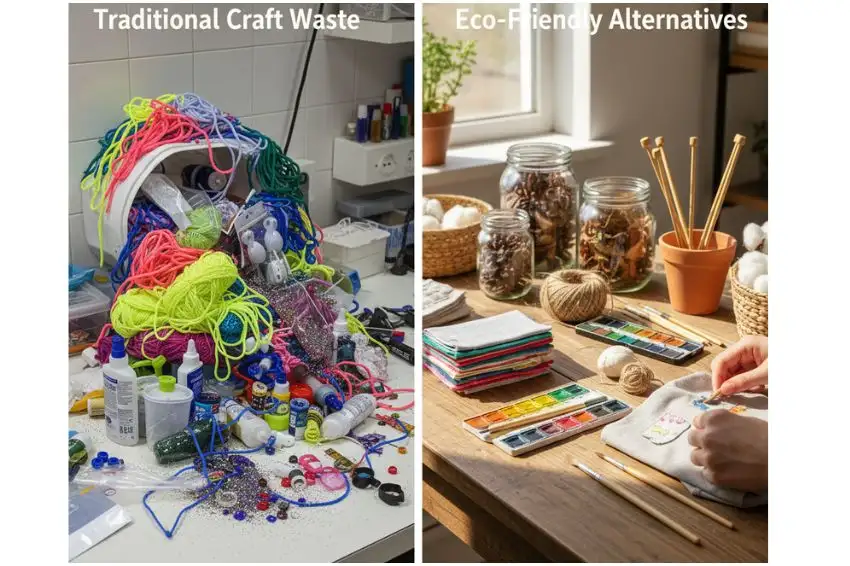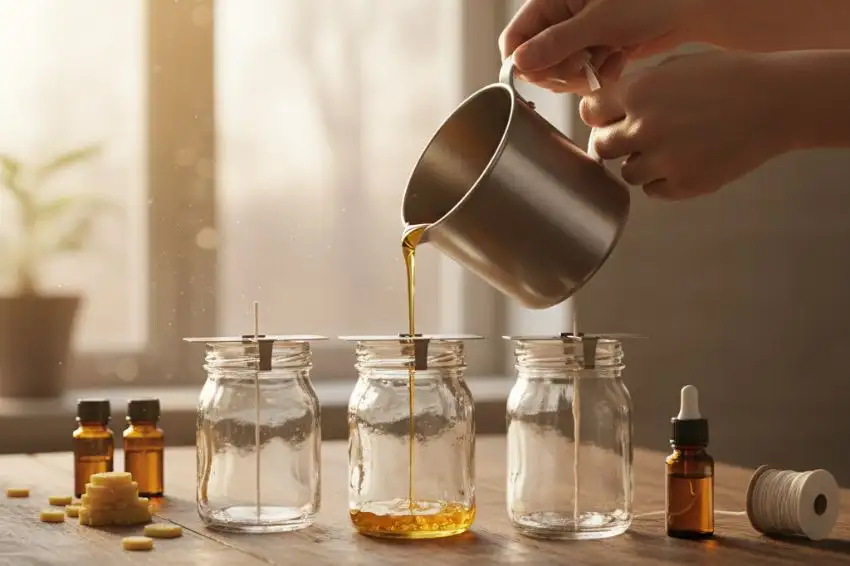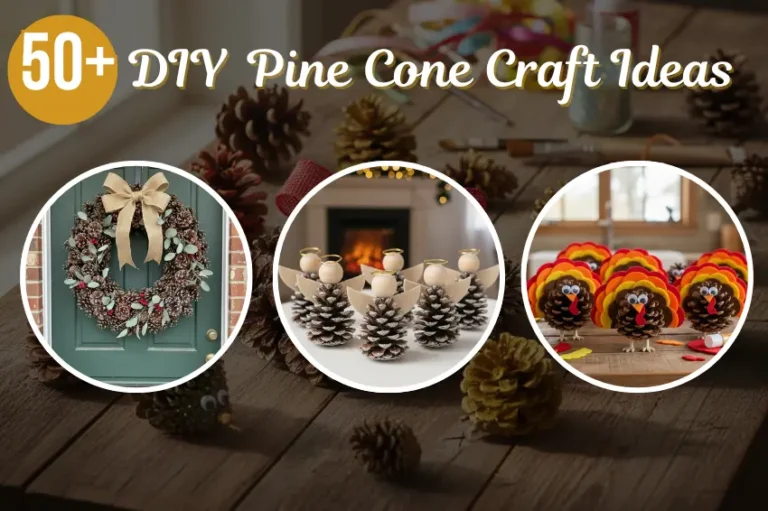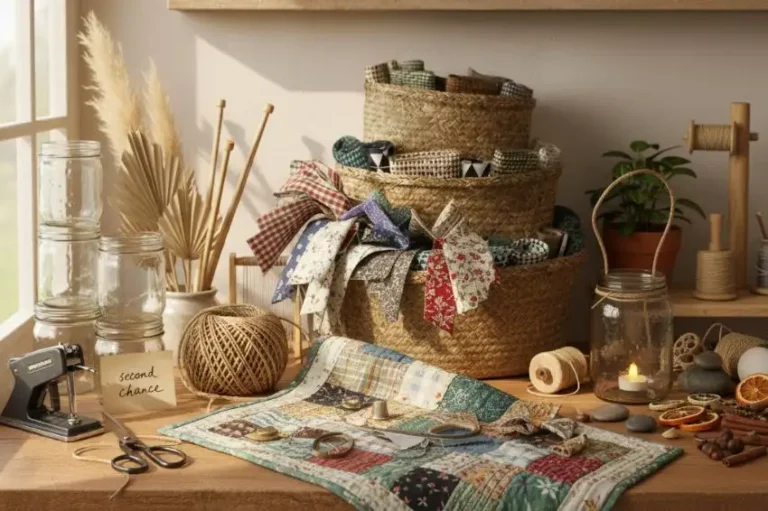Why Choose Eco-Friendly Crafting? Benefits for You and the Planet
Picture this: you’re sitting at your crafting table, sunlight streaming through the window, working on a beautiful project that makes your heart sing. Now imagine that same project doing something equally beautiful for the planet. That’s the magic of eco-friendly crafting—where creativity meets consciousness, and every snip of organic fabric or brushstroke of plant-based paint becomes a small act of environmental kindness.
We’re living in a time when our choices matter more than ever. The crafting industry, like many others, has traditionally relied on materials that aren’t exactly Earth’s best friends—synthetic fibers, toxic adhesives, and plastic packaging that’ll outlive us all. But here’s the exciting part: choosing eco-friendly crafting isn’t about sacrifice or settling for less. It’s about discovering a whole new world of materials, techniques, and possibilities that are actually better for your projects, your health, and yes, our beautiful blue planet.
So why should you make the switch? Buckle up, because we’re about to explore how sustainable crafts can transform not just your creative practice, but your entire relationship with making things.
What Is Eco-Friendly Crafting? (And Why It’s Cooler Than You Think)
Let’s start with the basics. Eco-friendly crafting means creating art and handmade projects using materials and methods that minimize environmental harm. Think of it as crafting with a conscience—choosing natural fiber crafts over synthetic ones, picking biodegradable craft materials instead of plastic, and embracing recycled paper crafts when you can.
But here’s what eco-friendly crafting isn’t: boring, limiting, or preachy. It’s not about giving up the crafts you love or feeling guilty about every supply in your stash. Instead, it’s about making thoughtful swaps that often work better anyway. Organic cotton fabric feels softer against your skin. Bamboo crafting tools are surprisingly sturdy and beautiful. Non-toxic paint for crafts means you’re not inhaling weird fumes while you work.
The environmentally friendly crafts movement is growing because makers like you are discovering that sustainable doesn’t mean sacrificing quality or creativity. If anything, working with natural materials often sparks more innovation—suddenly you’re thinking about upcycled crafts benefits and discovering that last year’s jeans make incredible patchwork quilts.
The Planet Perks: How Eco-Friendly Crafting Benefits the Environment

Let’s talk about the elephant in the room—or rather, the plastic mountain in the landfill. Traditional crafting has a dirty little secret: it generates a lot of waste. From synthetic fabric scraps that’ll take 200 years to decompose to toxic paint residue washing into waterways, our beloved hobby hasn’t always been kind to Mother Earth.
Breaking Down the Environmental Benefits
When you choose sustainable crafting techniques, you’re making a real difference. Here’s how:
Reduced Carbon Footprint Natural materials like organic cotton, bamboo, and jute require less energy to produce than synthetic alternatives. Bamboo, for instance, grows incredibly fast without pesticides and actually absorbs more carbon dioxide than most plants. Every time you pick up those bamboo knitting needles instead of plastic ones, you’re voting with your wallet for a cleaner production process.
Less Landfill Waste Biodegradable craft materials break down naturally when they’ve served their purpose. That natural wool felt you used for last month’s project? It’ll return to the earth harmlessly. Compare that to synthetic felt, which sits in landfills for decades, slowly releasing microplastics into the soil.
Cleaner Water Systems Plant-based non-toxic paints don’t contain the harsh chemicals that traditional craft paints do. When you wash your brushes, you’re not sending petroleum-based nasties down the drain and into rivers where fish live. It’s a small action with ripple effects—literally.
Supporting Ethical Production Many eco-friendly craft materials come from ethical sources that pay fair wages and use sustainable harvesting practices. Those handmade recycled glass beads? They’re often made by artisans in fair trade cooperatives, meaning your creative project supports real people and communities.
The Numbers Don’t Lie
| Environmental Impact | Traditional Crafting | Eco-Friendly Crafting |
|---|---|---|
| Plastic Waste Generated | High (synthetic materials, packaging) | Low to None (biodegradable, minimal packaging) |
| Carbon Emissions | Higher (petroleum-based production) | Lower (natural, renewable resources) |
| Water Pollution | Significant (toxic dyes, chemicals) | Minimal (plant-based, natural dyes) |
| Decomposition Time | 50-200+ years | Weeks to months |
| Renewable Resources | No (petroleum-based) | Yes (bamboo, cotton, hemp) |
Personal Benefits: What’s In It for You?
Now, being kind to the planet is wonderful, but let’s be honest—you also want to know how eco-friendly crafting improves your life. Good news: the benefits of sustainable crafts extend way beyond warm fuzzy feelings about saving trees.
Healthier Crafting Environment
Remember that headache you’d get after an afternoon of hot glue gun work? Or the weird smell from certain synthetic fabrics? With eco-conscious crafting tips in mind, you can kiss those issues goodbye. Biodegradable glue doesn’t release volatile organic compounds (VOCs) into your workspace. Natural fibers don’t off-gas mysterious chemicals. You’re literally breathing easier while you create.
I once had a friend who developed terrible allergies in her craft room. Turns out, it was the synthetic felt and conventional craft glue. She switched to natural wool felt sheets and plant-based adhesives, and within weeks, her symptoms vanished. Sometimes the universe sends us signals to go green, wrapped in sneezing fits.
Better Quality, Better Results
Here’s something that might surprise you: eco-friendly craft materials often outperform their conventional counterparts. Organic cotton fabric tends to be softer and more durable because it’s not weakened by harsh chemical treatments. Bamboo tools are strong, lightweight, and develop a beautiful patina over time. Even recycled paper packs can have more interesting textures and character than brand-new, bleached-white paper.
Cost Savings (Yes, Really!)
Are eco-friendly craft supplies more expensive? This is probably the biggest myth about sustainable crafts. While some specialized items might cost more upfront, many eco-friendly options actually save you money:
- Upcycling is free. Old clothes, cardboard boxes, glass jars—you’re literally crafting with “trash”
- Natural materials last longer. Quality bamboo sewing kits outlive cheap plastic ones by years
- DIY is budget-friendly. Making your own organic dye kits from kitchen scraps costs pennies
- Less is more. Zero waste crafting techniques teach you to use everything, reducing supply purchases
Plus, many eco-friendly materials are multipurpose. That spool of jute craft rope? Use it for macramé, package wrapping, garden ties, and rustic home decor. Your dollar stretches further when materials are this versatile.
Creative Inspiration and Skill Building
Working with sustainable materials forces you to think differently—and that’s a good thing. When you can’t just buy whatever’s convenient, you become more resourceful. You learn new techniques. You discover that plastic-free crafting ideas often lead to the most innovative projects.
There’s something deeply satisfying about creating beautiful things from humble materials. Those recycled fabric crafts carry stories. That hemp twine macramé wall hanging? It’s not just decor; it’s proof that you can make stunning art from sustainable resources.
What Materials Are Considered Eco-Friendly for Crafting?
Let’s get practical. When you’re standing in the craft store (or scrolling online), how do you know what’s actually eco-friendly? Here’s your go-to guide for sustainable crafting materials:
Natural Fibers
- Organic cotton: Grown without harmful pesticides, softer on skin and soil
- Bamboo: Fast-growing, renewable, naturally antibacterial
- Hemp: Incredibly durable, requires little water, improves soil health
- Jute: Biodegradable, strong, perfect for rustic projects
- Wool: Natural, renewable, biodegradable (choose ethically sourced)
- Linen: Made from flax, low environmental impact, beautiful drape
Paper Products
- Recycled paper and cardboard: Second life for materials that would be waste
- Tree-free paper: Made from bamboo, hemp, or cotton scraps
- Seed paper: Embedded with seeds, can be planted after use
Adhesives and Finishes
- Plant-based glues: Made from natural starches and resins
- Beeswax: Natural sealant and waterproofing agent
- Natural oils: Like linseed or tung oil for wood finishing
Coloring Agents
- Natural dyes: From plants, vegetables, and minerals
- Plant-based paints: Free from petroleum-derived chemicals
- Earth pigments: Traditional, non-toxic, beautiful subtle colors
Tools and Accessories
- Bamboo tools: Brushes, needles, crochet hooks, cutting mats
- Wooden implements: From sustainably managed forests
- Metal tools: Durable, recyclable, often last a lifetime
Where Can I Buy Sustainable and Eco-Friendly Crafting Materials?
Finding eco-friendly supplies is easier than you might think. Here’s where to look:
Online Specialty Shops: Websites focusing on green craft supply stores stock curated collections of sustainable materials. Look for shops that provide transparency about sourcing and production methods.
Local Craft Stores: Many mainstream retailers now carry eco-friendly lines. Check the labels for certifications like GOTS (Global Organic Textile Standard) or FSC (Forest Stewardship Council).
Etsy and Independent Makers: Support small businesses selling organic cotton fabric, handmade recycled glass beads, and other artisan eco-friendly materials.
Natural Food Stores: Surprisingly good sources for beeswax, organic dyes, and natural ingredients for DIY craft supplies.
Thrift Stores and Swap Groups: The ultimate eco-friendly shopping—giving existing materials new life through upcycled crafts benefits everyone.
Your Own Home: Before buying anything, shop your space. Old clothes become recycled fabric crafts. Cardboard boxes transform into sturdy canvases. Glass jars hold everything beautifully.
Top Product Picks to Get You Started
If you’re ready to build your eco-friendly craft stash, here are some favorites worth investing in:
Bee’s Wrap Beeswax Food Wraps make fantastic collage bases and mixed media surfaces, plus you can use them in your kitchen. Talk about multipurpose!
Bamboo Crafting Tools Sets give you quality implements that feel good in your hands and last for years. The smooth bamboo handles develop a warm patina with use.
Organic Cotton Fabric from ethical suppliers works beautifully for textile crafts—quilting, sewing, embroidery, you name it. It’s softer, breathes better, and holds dye more vibrantly than conventional cotton.
Natural Wool Felt Sheets are perfect for appliqué, soft toys, and decorative projects. Unlike acrylic felt, wool felt is sturdy, doesn’t pill, and eventually biodegrades.
Plant-Based Non-Toxic Paints deliver rich colors without the chemical smell. Your lungs (and your pet sleeping under your craft table) will thank you.
Eco-Friendly Crochet Yarn made from organic or recycled fibers creates gorgeous garments and home goods. Bonus: many sustainable yarns are incredibly soft and durable.
Can I Recycle Old Craft Materials for Eco-Friendly Projects?
Absolutely—and you should! This is where eco-friendly crafting gets really fun. Upcycling and recycling old materials is the ultimate zero waste crafting technique.
Fabric Scraps: Never throw away fabric pieces, no matter how small. Create quilts, stuffing for toys, cleaning rags, or cut them into strips for rag rugs. Those recycled fabric crafts often become treasured keepsakes.
Paper and Cardboard: Old magazines, junk mail, and shipping boxes are crafting gold. Make recycled paper crafts like handmade journals, collage art, or paper mache sculptures.
Glass Jars and Bottles: Clean them up for storage, turn them into vases, or use them for candle-making with your natural beeswax candles making kit.
Worn-Out Clothes: Buttons, zippers, and interesting fabric sections can be salvaged. Denim becomes sturdy tote bags. Old sweaters felt beautifully and transform into cozy pillows.
Plastic Containers: While we’re moving away from plastic, if you already have it, use it! Yogurt containers make paint palettes. Bottle caps become game pieces or mosaic tiles.
The key to successful recycling in crafting is organization. Keep a “future projects” bin where you toss interesting materials instead of recycling or trashing them. When inspiration strikes, you’ll have a treasure trove of free supplies waiting.
Simple Eco-Friendly Crafts for Beginners

Ready to dive in but not sure where to start? These beginner-friendly projects prove that sustainable crafting techniques are accessible to everyone:
1. Natural Dye T-Shirt Transformation
Grab a white or light-colored shirt (old one from your closet works great) and create gorgeous colors using kitchen ingredients. Turmeric for golden yellow, avocado pits for dusty rose, red cabbage for blues and purples. It’s like science class meets fashion design.
2. Seed Bomb DIY Kits
Mix wildflower seeds with recycled paper pulp and compost. Roll into balls, let dry, and you’ve got eco gardening crafts that beautify empty lots and help pollinators. Plus, they make fantastic gifts.
3. Beeswax Wrap Creation
Cut organic cotton fabric, brush with melted beeswax, and create reusable food wraps. They’re practical, pretty, and eliminate plastic wrap from your kitchen. People will beg you to make them for gifts.
4. Upcycled Fabric Bunting
Cut old clothes or fabric scraps into triangles, sew or glue onto hemp twine, and create charming decorations. Perfect for parties, kids’ rooms, or seasonal decor that you can swap out year after year.
5. Mason Jar Herb Garden
Use recycled glass jars, organic soil, and herb seeds to create a windowsill garden that’s both beautiful and functional. Bamboo plant markers complete the sustainable look.
6. Cardboard Loom Weaving
Cut notches in a piece of sturdy cardboard, string with hemp twine, and weave with fabric scraps or eco-friendly crochet yarn. You’ll create small tapestries, coasters, or wall art with virtually no investment.
7. Natural Beeswax Candles
Using a natural beeswax candles making kit, pour candles into reused glass containers. Add essential oils for fragrance if desired. They burn cleaner and longer than paraffin candles.
8. Recycled Paper Jewelry
Roll strips of magazine pages, old maps, or sheet music into beads. Seal with biodegradable glue, and string on hemp twine for unique necklaces and bracelets.
How to Ensure Your Craft Projects Are Truly Sustainable
Here’s where we get real: not everything labeled “eco-friendly” actually is. Greenwashing is unfortunately common in the craft supply industry. Here’s how to make sure your sustainable crafts are genuinely green:
Ask the Right Questions
- Where does this material come from? Look for transparency about sourcing
- How is it produced? Low-impact, ethical production matters
- What happens at end of life? Can it be composted, recycled, or safely disposed of?
- What’s the packaging? Sustainable products in plastic packaging defeat the purpose
Look for Certifications
- GOTS (Global Organic Textile Standard): Gold standard for organic fibers
- FSC (Forest Stewardship Council): Ensures sustainable forestry
- Fair Trade: Guarantees ethical production and fair wages
- OEKO-TEX: Tests for harmful substances in textiles
- Cradle to Cradle: Evaluates overall product sustainability
Practice Zero Waste Techniques
- Plan projects to minimize scraps
- Save every leftover bit for future use
- Share excess materials with other crafters
- Compost natural materials that can’t be used
- Buy only what you’ll actually use
Consider the Full Lifecycle
True sustainability means thinking beyond just the materials. How far did your supplies travel? Are you buying from ethical companies? Will your finished project last for years, or is it disposable? These questions help you make choices aligned with genuine environmental care.
Best Eco-Friendly Alternatives to Synthetic Fibers
Synthetic fibers have dominated crafting for decades because they’re cheap and consistent. But they’re also petroleum-based, shed microplastics, and never biodegrade. Here are natural alternatives that often work even better:
| Synthetic Fiber | Eco-Friendly Alternative | Why It’s Better |
|---|---|---|
| Polyester fabric | Organic cotton, linen, hemp | Breathable, biodegradable, softer |
| Acrylic yarn | Organic wool, cotton, bamboo yarn | Warmer, better drape, natural |
| Synthetic felt | Natural wool felt sheets | Sturdier, doesn’t pill, biodegrades |
| Nylon thread | Hemp twine, silk thread | Strong, natural, earth-friendly |
| Plastic-coated wire | Jute craft rope, copper wire | Biodegradable or recyclable |
| Foam stuffing | Wool roving, cotton batting | Natural, non-toxic, compostable |
Making the switch doesn’t mean starting from scratch. Begin by choosing natural fibers for your next project. As you use up synthetic materials, replace them with eco-friendly alternatives. It’s a gradual shift that becomes second nature.
Why Should I Choose Eco-Friendly Crafting Over Traditional Crafting?
Let’s bring it all together. If you’re still wondering whether eco-friendly crafting is worth the effort, consider this: every creative choice you make ripples outward.
When you choose sustainable crafts, you’re not just making a project—you’re participating in a movement. You’re showing manufacturers there’s demand for better materials. You’re teaching kids (or friends who peek at your Instagram) that beautiful things can come from conscious choices. You’re proving that we don’t have to sacrifice quality for sustainability.
Traditional crafting often prioritizes convenience and low cost, but at what price? Toxic fumes, environmental damage, and materials that outlast our great-grandchildren aren’t exactly the legacy most of us want to leave.
Eco-friendly crafting honors the full circle of creation—from material sourcing to finished project to what happens when it’s no longer needed. It connects us to the Earth, to ethical production practices, and to a community of makers who care about impact as much as aesthetics.
Plus, let’s be practical: eco-friendly DIY projects often result in higher quality, longer-lasting creations. That’s fewer replacements, less waste, and more value for your time and money. Win-win-win.
Getting Started: Your Eco-Friendly Crafting Action Plan
Feeling inspired but overwhelmed? Take it slow. Here’s your step-by-step approach to transitioning toward green crafts:
Week 1: Audit Your Supplies Look through your existing craft stash. What can you use up? What can be repurposed? What should you donate to someone who’ll use it? This isn’t about guilt—it’s about awareness.
Week 2: Make One Sustainable Swap Choose one item to replace with an eco-friendly version. Maybe it’s bamboo paintbrush set instead of plastic-handled brushes. Or organic dye kits instead of chemical dyes. One small change builds momentum.
Week 3: Try an Upcycling Project Challenge yourself to create something using only materials you already have at home. You’ll be amazed at what’s possible with “trash.”
Week 4: Connect with the Community Find online groups focused on environmentally friendly crafts. Share your projects, ask questions, get inspired. Community makes sustainable choices easier and more fun.
Beyond: Keep Learning and Growing Subscribe to eco-friendly crafting blogs. Visit local shops that specialize in sustainable materials. Experiment with new techniques. The journey toward sustainable crafting techniques is ongoing—and that’s what makes it exciting.
Conclusion: Crafting a Better Future, One Project at a Time
Here’s the beautiful truth about eco-friendly crafting: it’s not about perfection. You don’t need to overhaul your entire practice overnight or feel guilty about the synthetic materials still in your stash. What matters is intention and gradual progress.
Every time you choose organic cotton fabric over polyester, you’re making a difference. Every recycled paper craft keeps materials out of landfills. Every natural fiber craft you create is a small rebellion against throwaway culture. These choices accumulate into real change—for your health, your budget, and our shared home.
The benefits of eco-friendly crafting extend far beyond environmental impact. You’ll breathe cleaner air while you work. You’ll create higher-quality projects that last. You’ll connect with a passionate community of eco-conscious makers. You’ll feel the satisfaction that comes from aligning your creativity with your values.
So here’s your call to action: start where you are, use what you have, do what you can. Maybe that means buying a bamboo crafting tools set for your next project. Perhaps it’s finally turning those old jeans into a denim patchwork pillow. Or it could simply be pausing before purchases to ask, “Is there a more sustainable option?”
The planet doesn’t need a handful of people doing eco-friendly crafting perfectly. It needs millions of us doing it imperfectly—making thoughtful choices, learning as we go, and inspiring others through our creative work.
Your next project is waiting. Why not make it one that’s beautiful for you and the planet?
Ready to transform your crafting practice? Share your first eco-friendly project in the comments below! We’d love to see how you’re making sustainable choices in your creative work. And if you found this guide helpful, pass it along to a fellow crafter who might appreciate a greener approach to making.


